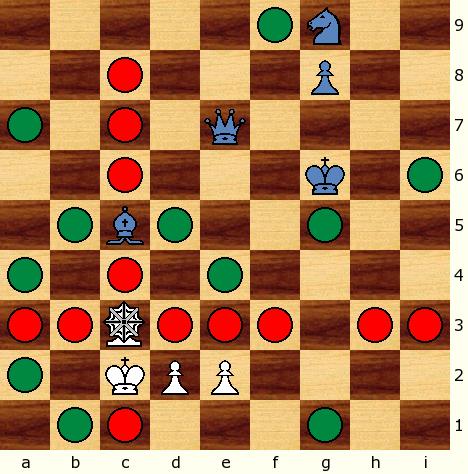Cetran Chess 2
This variant is a refinement of my before Cetina Random Chess proposal and follows the directrix of increasing at most the complexity of chess within the space of an 8x8 board.
Now the notion that bishops must be a pair is trascended and one is replaced by an Archbishop and the other by a Dragon Horse.
Cetran is an abbreviation of CETina RANdom, introduced in order to simplify a bit the names; so, the before proposal will be renamed as Cetran Chess 1.
Setup
The starting setup is determined at random on an 8x8 board.
Major pieces on ranks 1st and 8th; pawns on ranks 2nd and 7th.
You can choose to play without symmetry from one another side, or play with mirror or central symmetry.
See the presets below.
Pieces
Each player has:
 one King (K)
one King (K)
 one Queen (Q)
one Queen (Q)
 one Sissa (S)
one Sissa (S)
 one Chancellor (C)
one Chancellor (C)
 one Archbishop (A)
one Archbishop (A)
 one Dragon Horse (DH)
one Dragon Horse (DH)
 one Rook (R)
one Rook (R)
 one Knight (K)
one Knight (K)
 eight Pawns (P)
eight Pawns (P)
King, Queen, Rook, Knight and Pawn moves as is usual in FIDE Chess.
Chancellor moves each time as Rook or Knight.
Archbishop moves each time as Bishop or Knight.
Dragon Horse moves each time as Bishop or Wazir (Wazir = one orthogonal step horizontally or vertically).
Sissa moves each time as Rook AND Bishop following a movement pattern of the form nR+nB or nB+nR, where n is any whole number.
nR+nB means "first n squares like Rook followed by n squares like Bishop";
nB+nR means "first n squares like Bishop followed by n squares like Rook".
Then, if for instance n=5, Sissa MUST MOVE 5 squares as Rook followed by 5 squares as Bishop or viceversa.
There is no restriction on the movement direction of the second stage respecting to the first.
Sissa doesn't leap. All squares it passes by must be empty.
The following diagram illustrates its way of movement:

From c3, Sissa can reach the squares marked with green circlets by moving nightrider-wise; squares marked with red circlets are reached by moving rook-wise.
The i6 square is reached by c3-f3-i6. The c3-f6-i6 path is obstructed by the Blue's King. Likewise, f9 is reached via c3-f6-f9, not by c3-c6-f9 that is obstructed by the Bishop.
c8 is reached via c3-h3-c8, not via c3-h8-c8 that is obstructed by the g8-Pawn; c1 is reached via c3-a1-c1 or via c3-a3-c1 but not by c3-e3-c1 nor c3-e1-c1 that are both obstructed by the d2-Pawn.
a2, a4, b5, d5 and e4 can be reached by moving either like Mao or like Moa; b1 only like Moa; d1 is inaccessible due to the obstruction of White's King and d2-Pawn.
Concluding, the Bishop can be captured by 4 paths: c3-e3-c5 or c3-e5-c5 or c3-a3-c5 or c3-a5-c5. The Queen can only be captured by c3-e5-e7 since c3-c5-e7 is obstructed by the Bishop.
Rules
The same of FIDE Chess: pawns promotion, en passant, one or two steps at its first move.
The same object of the game, etc.
EXCEPT that castling is suppresed.
Notes
Fischer Random Chess (FRC), Cetran Chess 1 (CC1) and Cetran Chess 2 (CC2) are dialectically related. FRC is the thesis, CC1 the antithesis and CC2 the synthesis.Bobby was certainly very bold when proposed his random variant. His action could be seen metaphorically as the result of a strong gale, a devastating windstorm that suddenly broke the peace, the harmony and beauty of the traditional starting setup of chess.
When I knew it, my first impulsive reaction was of disgust, of disagreement, mainly because it was partially random given the two conditions he stated for both keep castling and bishops fall on squares of different color.
Then my reasoning reaction was to do a positive criticism [antithesis] by proposing CC1 which is absolutely random, 100% aleatory, taking advantage of the circumstances to complicate the game by introducing two new pieces: a Chancellor instead of a Rook, and a Sissa instead of a Knight.
After 10 years of playing CC1, I now make the synthesis of FRC and CC1.
It is noteworthy that CC2's piece set has a harmony, an equilibrium regarding the basic kinds of piece movements [bishop, rook, knight] since there are always 4 different pieces that can be moved according those types:
In another vein, I want to express my thanks to my dear friends Jose Carrillo, Joe Joyce and David Paulowich for helping me in many ways to make this page.
Special thanks to Matthew La Vallee for having designed the sissa icon.
Presets
Mirror-symmetric Cetran Chess 2
Central-symmetric Cetran Chess 2
Game Courier Logs
For Games of Cetina Random Chess = Cetran Chess 1
Cetran Chess 3
One more step in the same direction of increasing the complexity of the game.
Cetran Chess 3 Preset.
 This 'user submitted' page is a collaboration between the posting user and the Chess Variant Pages. Registered contributors to the Chess Variant Pages have the ability to post their own works, subject to review and editing by the Chess Variant Pages Editorial Staff.
This 'user submitted' page is a collaboration between the posting user and the Chess Variant Pages. Registered contributors to the Chess Variant Pages have the ability to post their own works, subject to review and editing by the Chess Variant Pages Editorial Staff.
By Carlos Cetina.
Last revised by Carlos Cetina.
Web page created: 2008-05-25. Web page last updated: 2022-11-24
